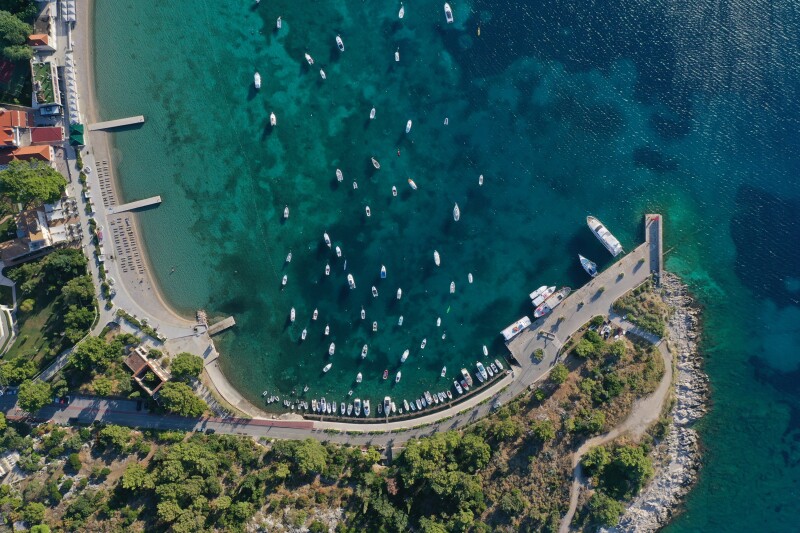With a tantalizing coastline and more than 1,000 islands to explore, it’s no wonder Croatia is topping everyone’s bucket list. Tourism in Croatia is flourishing, bringing 20.6 million tourist arrivals in 2023—a growth of 9 percent since 2022. Over more than two dozen visits during the past quarter century, I’ve watched Croatia transform into a top tourist destination, attracting visitors from around the world and making it increasingly challenging to find off-the-beaten-path places, especially during high season. But even on the popular Dalmatian Coast, you can still find under-the-radar spots that will make your trip more meaningful and memorable. You can create your own path by seeking out unique local culinary experiences, discovering less popular beaches, and visiting underrated islands.
Avoid the summer crowds by traveling in May or October—shoulder season is no longer June and September, especially in Dalmatia. “September has become the most popular month to visit Croatia, as our travelers see it as the first chapter of autumn,” says Wanda S. Radetti, founder of Tasteful Croatian Journeys, a pioneer in Croatia travel with more than 30 years of experience. “Evenings are cooler, yet the Adriatic Sea retains the warmth of the summer sun.”

Parking is limited at Srebreno Beach near Dubrovnik, so it never gets too swamped.
Photo by TP71/Shutterstock
Discover alternative Dubrovnik neighborhoods—then head to nearby beaches
“Croatia is so popular and it became hard to find any hidden gems but there are still some,” says Ivan Vuković, a Dubrovnik-based tour guide. Gruž and Lapad are less trodden than Dubrovnik’s Old Town, and the promenade that connects those neighborhoods is lined with bars, bistros, and cafés. Pebble beaches abound along the Croatian coastline; for sandy beach lovers, Srebreno Beach is a short drive from Dubrovnik’s Old Town, and Šunj Beach on Lopud Island—accessible by a ferry from Gruž—offers shallow water perfect for a lazy summer afternoon of swimming in the sea. (Be prepared for a 30-minute walk to the beach.)
“St. Pietro Island is a new restaurant on the island of Supetar in front of Cavtat, [with] great lounge vibes,” Vuković says. To get further off the beaten path, he suggests hiking from Cavtat to the Konavle region to spend time at Pasjača, one of the most attractive European beaches, where there is no cell phone signal. Afterwards, relax in a “domestic household” (traditional restaurant) like the family-owned Konoba Vinica Monković where you can cool off by the River Ljuta. “Visit us in the winter months,” he advises, adding that the Winter Festival offers open-air concerts from early December through early January, where you can mingle with locals and enjoy fewer crowds and cooler weather.

The 40-mile-long Pelješac peninsula in southern Dalmatia packs in vineyards, beaches, and seemingly endless views.
Photo by Tomislav Pinter/Shutterstock
Move on from Dubrovnik and head north to the Pelješac Peninsula
Dubrovnik has been contending with overtourism for years, ranking above Venice and Barcelona as the most touristed city in Europe. To avoid the tourist crush, Tasteful Croatian Journeys recommends heading an hour north to the Pelješac Peninsula and taking a boat tour through Mali Ston’s protected ecosystem to learn about the ancient process of cultivating the area’s exceptional oysters, which have a distinctive flavor thanks to the mineral-rich freshwater discharge from the nearby Neretva River. Pelješac is a famous Croatian grape-growing region, and you can visit vineyards like Saints Hills and Villa Korta Katarina and Winery, which also offer boutique luxury accommodations and fine dining restaurants.
The Tasteful Croatian Journeys team also recommends staying in Cavtat as a Dubrovnik alternative: This quaint, coastal town is 12 miles south of Dubrovnik and boasts a picturesque harbor and promenade, Renaissance architecture with elements of Gothic style, and a rich cultural and historical heritage, including a number of singular attractions like a seashell museum with 2,500 different types of shells. There, you can also find respite in quiet luxury: Housed in a 1920s villa, Hotel Supetar in Cavtat underwent extensive renovations and in 2022 reopened as a five-star boutique heritage property.
Look for encounters with local people
“From my experience, it is the moments in traveling that you remember for [your] whole life—and those moments almost always include making friends along that journey and having a feeling of connection with a place,” says Dubrovnik resident Zrinka Jelavić, founder of Tailored Croatia, which offers bespoke local experiences. Following that principle, her company creates experiences designed for the individual. “[One of] our client[s] expressed interest for Croatian art [so] we organized a tour where, among other things, they met a local artist in the small picturesque town of Grožnjan in Istria, the town of the artists,” Jelavić says. Guests had the opportunity to be invited into his home and gallery and shared an intimate conversation about his life, work, and art. “The encounter finished with hugs and exchanged contacts and promises [of] staying in touch long after they left Croatia.”

Sample a glass of orange wine and some locally sourced pasta or fish before retiring to one of the 32 rooms and suites at Roxanich Hotel and Winery.
Courtesy of Roxanich Hotel and Winery
Skip other popular cities for quieter towns
In Istria—a heart-shaped northern peninsula dangling into the Adriatic Sea—the coastal cities of Pula and Rovinj receive the lion’s share of overnight visitors. Instead, head into Istria’s bucolic interior to discover truffle-rich forests and medieval hilltop towns like Motovun and Grožnjan. Tasteful Croatian Journeys recommends the chic Roxanich Design Hotel and Winery, below Motovun, and a short distance away, Stanzia Vinella offers modern amenities in a 400-year-old farmhouse where guests are free to pick their own vegetables from the villa’s garden. Visiting local markets is an education in itself, where you can rub shoulders with locals and learn about the culture from what is grown and consumed.
On Saturdays, visit Mini Farmers’ Market in Vrsar Old Town, where you can taste and buy local products directly from producers; or head inland to the Summer Market in Pićan, which features an array of products from local farms. “Personally, one of my favorite things to do when I travel is visiting local farmers’ markets, of which Croatia has plenty,” says Tia Lovisa Moreira, vice president of Tasteful Croatian Journeys, adding that travelers who are planning a longer stay in Croatia might consider a villa or luxury apartment rental with a kitchen. For outdoor enthusiasts, Istria’s interior offers unspoiled nature with hiking and biking trails, such as a trail featuring views of Buzet’s medieval town that also runs along the Mirna River.
Small rural establishments offer authentic experiences and a way to give back to the community: Toklarija, a slow food restaurant run by a father and son housed in an old olive mill in Istria’s Buzet area (aka “city of truffles”), provides an intimate dining experience highlighting local products with a seasonal menu that changes every few weeks. At Casa Matiki—a charming farmhouse near the village of Žminj, in the heart of Istria— learn to make fuži (traditional homemade Istrian pasta) or try your hand at making delicious jams from the surrounding orchards’ bounty. Istria offers a wealth of culinary adventures: Go truffle hunting with Miro Tartufi and take a cooking class with EatIstria at a small farm and olive grove located in the Istrian countryside, which EatIstria founder Goran Zgrablić inherited from his grandmother and refurbished into a semi-open cooking studio. “We offer not only classes of traditional and modern Istrian cuisine—through our intimate, relaxed approach, we immerse our guests fully into Istrian culture and life, making them feel as if they were visiting a friend’s home,” says Nikola Pezić, manager of EatIstria.

Villa Nai 3.3 hotel is situated halfway between Venice and Dubrovnik and is open from April to October.
Photo by Tom Dubravec / CROPIX
Explore lesser-known islands
No visit to Croatia is complete without visiting an island or two. In Kvarner Bay, the island of Lošinj is revered as a wellness destination due to its superior air quality and 2,600 hours of annual sunshine. The island’s town of Mali Lošinj features the Museum of Apoxyomenos, dedicated to the bronze statue of a young athlete, Apoxyomenos, which was discovered in 1997 by a Belgian diver after spending nearly two millennia under the sea. On Lošinj, villas affiliated with and serviced by five-star Boutique Hotel Alhambra are perfect for extended family gatherings, including Villa Sea Princess Nika, a seven-suite villa with views of ancient pines and tranquil Čikat Bay.
Further down the coast near Zadar, the islands of Pag and Dugi Otok offer a range of memorable experiences. Known for its distinctive award-winning sheep’s milk cheese, Paški sir (Pag cheese), Pag left enough of an impression on me to inspire my debut novel, The Cheesemaker’s Daughter. Take a tour of a cheese factory at Sirana Gligora or Paška Sirana and learn about the island’s cheesemaking history, and sample some of Pag’s fine gastronomy at Michelin-starred Restaurant Boškinac, known for its creative approach to traditional island cuisine. (You can also stay overnight in Boškinac’s boutique accommodations.) The island’s rich heritage is evident in the olive gardens of Lun, which contain some of the oldest olive trees in the world, while the Gallery of Pag Lace showcases Pag’s needlepoint lacemaking tradition, registered in the UNESCO World Heritage list in 2009.
Dugi Otok, or “Long Island,” is home to Telaščica Nature Park, and neighboring Kornati National Park offers some of the most dramatic natural wonders in coastal Croatia—including 89 islands, islets and reefs rich in biodiversity—as well as “crowns,” striking cliffs that are are part of a significant tectonic fault line, which contribute to the unique geological landscape. Villa Nai 3.3 on Dugi Otok offers an annual experience between late September and early October where guests can participate in a traditional olive harvest with local farmers, connecting them to the island’s heritage. The olives are processed in the hotel’s state-of-the-art mill the same day, and you can take a souvenir bottle back home.











